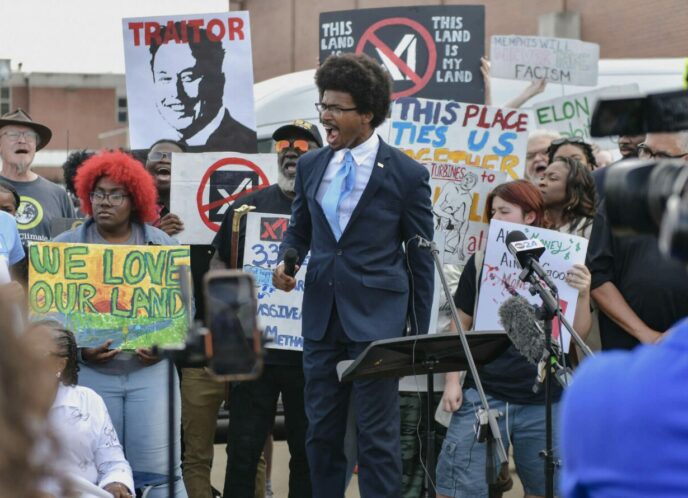By Roberto Lovato / Reposted from Colorlines.com
Update @ 5:15pm ET: A YouTube video (below) is circulating of a protester who appears to have been struck in the face by a projectile fired by police, presumably one of many tear gas canisters police fired into the crowd during last night’s march. Huffington Post reports that the man is an Iraq war vet named Scott Olson, 24. Olson is reportedly in critical care, with swelling in his brain. In the video, as others rush to Olson’s aid, an officer fires what appears to be a flash-bang grenade into the crowd of people helping him.
Colorlines.com contributor Ali Winston has been following the story. In August, Colorlines published a year-long investigation by Winston that detailed how OPD officers with chronic use-of-force complaints remain on duty without public scrutiny. Winston will have more details on this week’s violence and the broader context for it on Friday. —Editors
+++++
While President Obama was telling the small crowd at a $7500-a-plate fundraiser in San Francisco that “Change is possible,” Pooda Miller was across the bay trying to get her plate back from the Oakland Police Department. “They came, pulled out rifles, shot us up with tear gas and took all our stuff,” said Miller, at an afternoon rally condemning the violent evacuation of more than 170 peaceful, unarmed Occupy Oaklanders by 500 heavily-armed members of the Oakland Police Department and other local departments yesterday morning.
With a long metal police fence separating Miller and other members of Occupy Oakland from their confiscated items—tents, water, food, clothes, medicine, plates—and now possessed by the police, Miller grabbed a big blue and white bullhorn that looked like it was almost half of her 4-foot, 5-inch frame. “Give us our stuff back! It don’t belong to you!” yelled Miller, who also expressed relief that her baby was not camped out with her that morning.
The sound of Miller’s ire shot across the protective masks of all of the officers standing at alert on the other side of the metal police fence, but her loudest, most acidic anger was saved for the baton-wielding officer who, like herself and other officers, was a young African-American woman.
“Who are you serving?” screamed Miller at the top of her high pitched voice, turned raspy from hours of denouncing. “You’re being used. You’re getting paid with our tax money to put down your own people! Why are you doing this to your own people?”
Miller’s questions about the role of race in the policing of Occupy Oakland points to what is and will continue to be the larger question in Oakland and other U.S. cities where former “minorities” are becoming majorities: What does it mean when those charged with defending elite interests against multi-racial and increasingly non-white activists are themselves multiracial and non-white? The ongoing protests, mayor recall, phone calls, emails and other pressure and pushback of Occupy Oakland are no longer aimed at cigar-smoking white men. They are aimed at a power structure in Oakland whose public face looks more like Miller and other non-white protesters.
Miller and others are calling for the recall of Jean Quan, who made history as Oakland’s first Asian-American mayor (full disclosure: Quan’s daughter is my Facebook friend); and they are complaining about the use of excessive police violence authorized by Interim Chief Howard Jordan, an African American. Such conflicts between former minorities are becoming the norm in what more conservative commentators call the “post-racial” era ushered in by the election of Obama.
Quan and Jordan are in the throes of dealing with a police department plagued by officer-involved shootings and killings, corruption and other crimes—crimes that have forced a federal consent decree to reform the department, after officers were convicted of planting evidence and beating suspects in West Oakland. Taking her cue from the Obama campaign of 2008, Quan announced Jordan’s appointment at a public safety forum titled “Creating Hope in the Community.”
Many like Miller and other Occupy Oaklanders are having second thoughts about what feels like the affirmative actioning of policing and state violence. Others, like Ofelia Cuevas of the University of California’s Center for New Racial Studies, see the workings of a not-so-21st-century pattern of policing and power.
“Having people of color policing people of color is not new,” said Cuevas. “This was part of policing history in California from the beginning. In the 1940s, while the federal government was interning Japanese Americans in camps, officials in Los Angeles were starting to recruit black police officers as a way to decrease police brutality.”
Cuevas noted that big city mayors like Quan or Los Angeles Mayor Antonio Villaraigosa are, by electoral and structural necessity, required to act like any of their predecessors, who headed up police forces that attacked, surveilled and even killed those perceived as a threat to the establishment. The Bay Area police’s violent modern history stretches from OPD’s assault on the Black Panther Party—which was founded just blocks from the center of Occupy Oakland, re-named Oscar Grant Plaza—to the killing of Grant, a young black man shot in the back by a transit police officer at a nearby train station.
“Being mayor is being pro-police. They perceive that it’s their job to crush what they consider threats to the status quo,” said Cuevas.
Regardless of who is Mayor or police chief, keeping the status quo is the last thing that Gaston Lau, a 21 year-old english major at University of California, Berkeley, sees as an option. “[Quan’s] support for this amount of police brutality here is ridiculous,” said Lau, who held a placard that said “Down, Down with Jean Quan.”
“The future power struggles are not just going to be about fights between one race and another,” said Lau. “They’re mostly going to be about class, which is a big part about what the whole Occupy movement is about.”
Lau is hopeful that the movement will inspire younger Asian Pacific Islanders to engage with the issues of the Occupy moment, but worries about the generational conflict such a political engagement entails. “Some older Chinese might see having one of our own as mayor as a source of pride, but we need to help them understand how Quan and police act against us.”
Despite the internal and external challenges posed by multicultural powers putting down multicultural movements, Lau is, like his Occupy Oakland peers, undeterred. Clashes between Occupiers and Oakland police continued into last night as protesters tried to reclaim the park and police met them with tear gas. The movement has vowed to continue attempting to return to the space. “Whether or not the mayor is Asian,” Lau said, “when she acts against the people, then we will respond as the people.”
Roberto Lovato is a founding member of Presente.org and a regular contributor to Colorlines.com.



